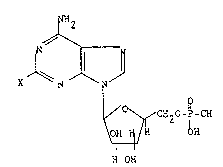Some of the information on this Web page has been provided by external sources. The Government of Canada is not responsible for the accuracy, reliability or currency of the information supplied by external sources. Users wishing to rely upon this information should consult directly with the source of the information. Content provided by external sources is not subject to official languages, privacy and accessibility requirements.
Any discrepancies in the text and image of the Claims and Abstract are due to differing posting times. Text of the Claims and Abstract are posted:
| (12) Patent Application: | (11) CA 2172817 |
|---|---|
| (54) English Title: | METHOD OF PREPARING ARABINONUCLEOTIDES |
| (54) French Title: | PROCEDE DE PREPARATION D'ARABINONUCLEOTIDES |
| Status: | Deemed Abandoned and Beyond the Period of Reinstatement - Pending Response to Notice of Disregarded Communication |
| (51) International Patent Classification (IPC): |
|
|---|---|
| (72) Inventors : |
|
| (73) Owners : |
|
| (71) Applicants : | |
| (74) Agent: | SMART & BIGGAR LP |
| (74) Associate agent: | |
| (45) Issued: | |
| (86) PCT Filing Date: | 1994-09-06 |
| (87) Open to Public Inspection: | 1995-04-06 |
| Examination requested: | 2001-08-13 |
| Availability of licence: | N/A |
| Dedicated to the Public: | N/A |
| (25) Language of filing: | English |
| Patent Cooperation Treaty (PCT): | Yes |
|---|---|
| (86) PCT Filing Number: | PCT/EP1994/002949 |
| (87) International Publication Number: | WO 1995009244 |
| (85) National Entry: | 1996-03-27 |
| (30) Application Priority Data: | ||||||
|---|---|---|---|---|---|---|
|
A process for the production of arabinonucleotides of
general formula I
<IMG>
(I),
in which
X represents a hydrogen atom or a fluorine atom, is
described, which is characterized in that an
arabinonucleoside of general formula II
<IMG> (II),
in which X has the above-mentioned meaning, is
fermented in the presence of an aryl phosphate of
general formula III
<IMG> (III),
in which
Y symbolizes a hydrogen atom or a nitro group and
Z symbolizes two hydrogen atoms or two alkali metal
atoms,
with a microorganism that is capable of phosphorylating
nucleosides.
L'invention concerne un procédé de préparation d'arabinonucléotides de la formule générale (I), dans laquelle X désigne un atome d'hydrogène ou un atome de fluor. Ce procédé se caractérise en ce que l'on fait fermenter un arabinonucléoside de la formule générale (II) dans laquelle X a la notation mentionnée ci-dessus, avec un micro-organisme apte à la phosphorylation de nucléosides en présence d'un phosphate d'aryle de la formule générale (III), dans laquelle Y désigne un atome d'hydrogène ou un groupe nitro et Z désigne deux atomes d'hydrogène ou deux atomes de métal alcalin.
Note: Claims are shown in the official language in which they were submitted.
Note: Descriptions are shown in the official language in which they were submitted.

2024-08-01:As part of the Next Generation Patents (NGP) transition, the Canadian Patents Database (CPD) now contains a more detailed Event History, which replicates the Event Log of our new back-office solution.
Please note that "Inactive:" events refers to events no longer in use in our new back-office solution.
For a clearer understanding of the status of the application/patent presented on this page, the site Disclaimer , as well as the definitions for Patent , Event History , Maintenance Fee and Payment History should be consulted.
| Description | Date |
|---|---|
| Inactive: IPC from MCD | 2006-03-12 |
| Inactive: IPC from MCD | 2006-03-12 |
| Application Not Reinstated by Deadline | 2004-09-07 |
| Time Limit for Reversal Expired | 2004-09-07 |
| Deemed Abandoned - Failure to Respond to Maintenance Fee Notice | 2003-09-08 |
| Inactive: Status info is complete as of Log entry date | 2001-09-21 |
| Inactive: Application prosecuted on TS as of Log entry date | 2001-09-21 |
| Letter Sent | 2001-09-21 |
| Request for Examination Requirements Determined Compliant | 2001-08-13 |
| All Requirements for Examination Determined Compliant | 2001-08-13 |
| Letter Sent | 1997-10-14 |
| Reinstatement Requirements Deemed Compliant for All Abandonment Reasons | 1997-09-30 |
| Deemed Abandoned - Failure to Respond to Maintenance Fee Notice | 1997-09-08 |
| Application Published (Open to Public Inspection) | 1995-04-06 |
| Abandonment Date | Reason | Reinstatement Date |
|---|---|---|
| 2003-09-08 | ||
| 1997-09-08 |
The last payment was received on
Note : If the full payment has not been received on or before the date indicated, a further fee may be required which may be one of the following
Please refer to the CIPO Patent Fees web page to see all current fee amounts.
| Fee Type | Anniversary Year | Due Date | Paid Date |
|---|---|---|---|
| Reinstatement | 1997-09-30 | ||
| MF (application, 3rd anniv.) - standard | 03 | 1997-09-08 | 1997-09-30 |
| MF (application, 4th anniv.) - standard | 04 | 1998-09-08 | 1998-08-24 |
| MF (application, 5th anniv.) - standard | 05 | 1999-09-07 | 1999-08-31 |
| MF (application, 6th anniv.) - standard | 06 | 2000-09-06 | 2000-08-17 |
| Request for examination - standard | 2001-08-13 | ||
| MF (application, 7th anniv.) - standard | 07 | 2001-09-06 | 2001-08-29 |
| MF (application, 8th anniv.) - standard | 08 | 2002-09-06 | 2002-08-21 |
| MF (application, 2nd anniv.) - standard | 02 | 1996-09-06 |
Note: Records showing the ownership history in alphabetical order.
| Current Owners on Record |
|---|
| SCHERING AKTIENGESELLSCHAFT |
| Past Owners on Record |
|---|
| ALFRED WEBER |
| HEIDI HUMMEL-MARQUARDT |
| MARIO KENNECKE |
| THOMAS SCHMITZ |